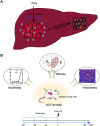Prospect of Animal Models for Acute-on-chronic Liver Failure: A Mini-review
- PMID: 36304511
- PMCID: PMC9547251
- DOI: 10.14218/JCTH.2022.00086
Prospect of Animal Models for Acute-on-chronic Liver Failure: A Mini-review
Abstract
Acute-on-chronic liver failure (ACLF) is a clinical syndrome that develops in patients with chronic liver diseases following a precipitating event and associated with a high mortality rate due to systemic multiorgan failure. Establishing a suitable and stable animal model to precisely elucidate the molecular basis of ACLF pathogenesis is essential for the development of effective early diagnostic and treatment strategies. In this context, this article provides a concise and inclusive review of breakthroughs in ACLF animal model development.
Keywords: Acute-on-chronic liver failure; Animal model; Hepatotoxicants; Inflammation; Liver failure.
© 2022 Authors.
Conflict of interest statement
JL has been an editorial board member of Journal of Clinical and Translational Hepatology since 2019. HMH has no conflict of interests related to this publication.
Figures

Similar articles
-
Acute-on-chronic liver failure in cirrhosis.Nat Rev Dis Primers. 2016 Jun 9;2:16041. doi: 10.1038/nrdp.2016.41. Nat Rev Dis Primers. 2016. PMID: 27277335 Review.
-
Acute-on-chronic liver failure is a distinct syndrome that develops in patients with acute decompensation of cirrhosis.Gastroenterology. 2013 Jun;144(7):1426-37, 1437.e1-9. doi: 10.1053/j.gastro.2013.02.042. Epub 2013 Mar 6. Gastroenterology. 2013. PMID: 23474284
-
Acute-on-chronic liver failure (ACLF) in 2022: have novel treatment paradigms already arrived?Expert Rev Gastroenterol Hepatol. 2022 Jul;16(7):639-652. doi: 10.1080/17474124.2022.2097070. Epub 2022 Jul 7. Expert Rev Gastroenterol Hepatol. 2022. PMID: 35786130 Review.
-
Acute on chronic liver failure: definitions, treatments and outcomes.Curr Opin Gastroenterol. 2016 May;32(3):172-81. doi: 10.1097/MOG.0000000000000265. Curr Opin Gastroenterol. 2016. PMID: 27023163 Review.
-
Preoperative TIPS prevents the development of postoperative acute-on-chronic liver failure in patients with high CLIF-C AD score.JHEP Rep. 2022 Jan 21;4(3):100442. doi: 10.1016/j.jhepr.2022.100442. eCollection 2022 Mar. JHEP Rep. 2022. PMID: 35198929 Free PMC article.
Cited by
-
Nothing but NET: A Novel Model of Alcohol Induced Acute-on-Chronic Liver Failure Demonstrates Both Enhanced Mechanistic Insight and a Possible Therapeutic Pathway.Cell Mol Gastroenterol Hepatol. 2025;19(4):101455. doi: 10.1016/j.jcmgh.2024.101455. Epub 2025 Jan 17. Cell Mol Gastroenterol Hepatol. 2025. PMID: 39832757 Free PMC article. No abstract available.
-
Ethanol Extract of the Microalga Phaeodactylum tricornutum Shows Hepatoprotective Effects against Acetaminophen-Induced Acute Liver Injury in Mice.Int J Mol Sci. 2024 Jun 6;25(11):6247. doi: 10.3390/ijms25116247. Int J Mol Sci. 2024. PMID: 38892435 Free PMC article.
-
Thrombospondin 1 enhances systemic inflammation and disease severity in acute-on-chronic liver failure.BMC Med. 2024 Mar 5;22(1):95. doi: 10.1186/s12916-024-03318-x. BMC Med. 2024. PMID: 38439091 Free PMC article.
References
-
- Qin L, Crawford JM. Zakim and Boyer’s hepatology: A textbook of liver disease. 7th edition. Elsevier, Inc.; 2018.
-
- Vaja R, Rana M. Drugs and the liver. Anaesth Intensive Care Med. 2020;21(10):517–523. doi: 10.1016/j.mpaic.2020.07.001. - DOI
Publication types
LinkOut - more resources
Full Text Sources
